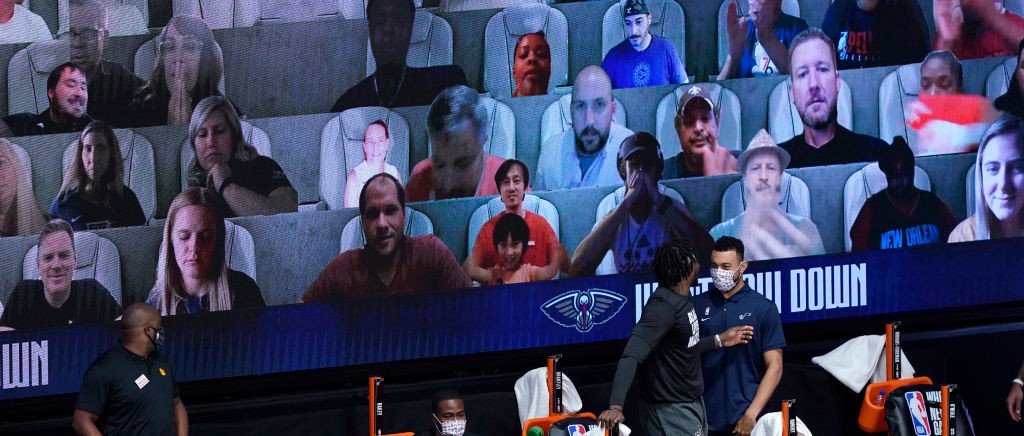
The experience of watching sports in empty stadiums can be a bit jarring. Beyond the fact that games are happening without fans — a visually strange experience, albeit one that teams in soccer and hockey have tried to fix by having banners unfurled over the empty seats — sounds of the game have varied based on what you’re watching and who is broadcasting. Some leagues/networks have opted for natural sounds to lead the way, while others have decided to use artificial crowd noise in an attempt to give a more authentic experience.
The results have been mixed. While some view it as a welcomed addition, others haven’t particularly enjoyed something so inauthentic, particularly when the potential other option is something as interesting as athletes communicating on their playing surfaces with one another. While this is probably a nightmare for whomever has to make sure the FCC is happy stateside, for fans, it’s an opportunity to get a glimpse into everything — the verbiage, the banter, etc. — that you can normally only get by sitting right next to a game.
ESPN, which has some experience in this field due to its role in broadcasting the MLS Is Back tournament alongside Fox Sports, is opting to go with an approach that makes these unusual games feel a little more familiar, according to Mike Shiffman, the network’s Vice President, Production.
“It’ll be a mix of some of the crowd noise that’s natural to who the home team is, along with music and prompts, along with obviously the sneaker squeaks which are really cool as the NBA put more than 30 microphones beneath the court, and of course, the talk and chatter from the players,” Shiffman told the assembled media during a Zoom call earlier this week.
Shiffman is part of ESPN’s sizable contingent down in the bubble. The Worldwide Leader is, of course, not the only network tasked with airing games, as Turner will split seeding games and postseason tilts up until the Finals roll around, at which point ABC will broadcast everything across its airwaves. As Shiffman says, the undertaking has been gigantic to get up to this point, and praises the league for doing “a remarkable job” both when it comes to putting together an environment conducive to basketball and one that keeps individuals safe amid a global pandemic.
“Mid-to-late June, myself, Tim Corrigan who is our lead NBA producer and of course produces the NBA Finals, and Jimmy Moore, who is a director and works alongside Tim on the NBA Finals and our biggest games, came down here to Orlando with folks from the league and folks from Turner for a site survey,” Shiffman recalls. “And we literally went arena-by-arena with drawings and went through what was possible.”
The result is a multi-stadium operation, one that will help broadcast games on regional sports networks. As part of this broadcast, ESPN is going to use a rail cam, which shows the game from a slightly different angle.
All of this is part of making the experience unique, something that is rarely afforded to broadcasters due to the inherent nature of how we consume sports. Broadcasts go the way they go because they work best this way, arenas are built to accommodate that specific thing. That familiarity will be lost, of course, in this environment, but as Shiffman notes, the league is going to try to use audio to give some semblance of familiarity to those tuning in.
“One of the things the league has done really well here is that they’re making it sort of natural to who the home team is,” Shiffman says. “So if it’s a Lakers game, it will sound like Staples, whether it be the music being played, the PA, or what the fans would sound like in Staples, which may be different from Milwaukee and Boston, etc. I think that’s been, to me at least, it feels authentic in that way in that it sounds like what a Laker home game would sound like.”
Anyone who has followed along with the various soccer leagues restarting knows that using these noises can be unpopular. Shiffman says that ESPN has a team that is constantly evaluating how these sorts of new ideas are being received, and that after Friday’s games, it’ll be evaluated alongside what the league and Turner believe based on their feedback, too.
That feedback isn’t just important for this season, either. In Shiffman’s eyes, while this is something they’ll discuss down the road, the bubble presents ESPN the opportunity to test things out for a little farther down the road.
“We’ve started those conversations of ‘What can we take from what we’re doing here and apply to future years?’” Shiffman says. “I don’t know if we have any set plans, we haven’t done a full-on regular season game yet. But obviously knowing that when there are fans back — some of these opportunities do come because there aren’t fans in the arena — that when there are fans in the arena, are there things we can take to that blueprint of fans in the arena.”
